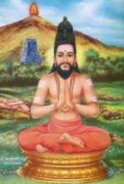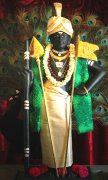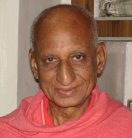

THE ESOTERIC
KANDAR ANUBHUTI
OR
THE SECRET TEACHING ON
GOD-EXPERIENCE
(A Treatise on Adwaitic Realization)
OF
SAINT ARUNAGIRINATHAR

 |  THE ESOTERIC KANDAR ANUBHUTI OR THE SECRET TEACHING ON GOD-EXPERIENCE (A Treatise on Adwaitic Realization) OF SAINT ARUNAGIRINATHAR |  |
 | by N.V. Karthikeyan |  |
| verses contents 36 37 38 39 40 41 42 43 44 45 .. 51 this verse in PDF version (6 parts) p-1 p-2 p-3 p-4 p-5 p-6 complete download of this book |
VERSE-41 சாகாது எனையே சரணங்களிலே காகா நமனார் கலகம் செயுநாள் வாகா முருகா மயில் வாகனனே யோகா சிவஞான உபதேசிகனே.Saagaathu enaiye saranangkalile, Kaakaa namanaar kalakam cheyunaal Vaakaa murugaa mayil vaaganane Yogaa siva jnaana upathesikane. Save me from transmigration and, under your Lotus Feet, Commentary The Sannyasin-disciple undertook uninterrupted meditation on the Vel to attain Liberation, thereby freedom from phenomenal life or future births (verse-40) (Jnana). That aspiration of his is fortified and confirmed and clarified in this verse by a prayer (Bhakti). He wants immediate Realization of God and not wait till the body dies, to attain God. He has so much advanced in his meditation due to his determined and intense practice that he feels very close to Realization, so much so that he wants to be granted Jivanmukti, i.e. Liberation here and now, while still living in this body, to ensure no more births. He is aware that one day Yama will come and do his duty and he is not afraid of that, which is clear from 'Namanaar kalagam seyunaal', because he knows physical death cannot be avoided by anyone, not even the Avataras, as it is against the law of Nature. Liberation here and now (Jivanmukti) does not mean liberation at some particular 'place' or 'time'. It is to go beyond the limitations of time and space. It is God-realisation while the body is still alive, and to live with an awareness of omnipresence and omniscience. Swami Sivananda says: "The Yogi has simultaneous knowledge. The past and future are blended into the present. Everything is 'now'. Everything is 'here'. He has transcended time and space." சரணங்களிலே காகா -- "Saranangkalile Kaa Kaa" -- "Protect me, protect me under Your Feet." 'Kaa' means 'protect'. Protect is said twice to show his intense longing for immediate Liberation while still living in this body, and not wait till the death of the body. It is not an urgent call for protection from Yama as if he has come or is about to come; his coming is still far away which is clear from 'kalagam seyum naal' - 'that day when Yama will play his mischief'. The prayer is, therefore, not for saving from death or Yama, but for Immediate Liberation and consequent freedom from rebirth ('saagaathu' சாகாது). Yama's coming and doing his mischief of separating the soul from the body is certain and unavoidable for everyone; anything that is born has to perish, even Avataras and sages had to shed their bodies. So, 'saagaathu' is not freedom from death of this physical body, but from rebirth. When a person dies, Yama separates the soul from the body but he cannot touch the soul if it is already Liberated or 'protected under the Lord's Feet'. Only the souls that are not Liberated or so protected can he take and allot the next birth according to their Karmas. It is the soul that departs and is reborn, not the body. Thus it is called 'death' (சாதல்) when it entails rebirth or transmigration for the soul, and non-death (சாகாது) when no rebirth is involved. In the case of Liberated souls or saints and sages there is no more birth, no transmigration, and so no death either (சாகாது). Hence, when they shed the body, they are not said to have died, but attained 'Immortality' (அமரர் ஆனார்) and if they are Sannyasins, it is said, 'he has attained Mahasamadhi'. Thus the prayer of the verse is: "At that time whenever Yama does his mischief (of separating the soul from the body) (நமனார் கலகம் செயுநாள்), in order that he may not take possession of my soul and ordain rebirth, (சாகாது) i.e. there may not be a need for transmigration or rebirth; under Your Feet (சரணங்களிலே) protect me here (எனை கா) and protect me now (கா)." (இங்கேயே இப்பொழுதே சரணங்களிலே காப்பாற்று). The prayer of this verse is a little different from that of Verse-10 which was to protect him from Yama if he comes, as he did not want to die before attaining the Goal. Here it is for Immediate Liberation; let Yama come when he has to. The prayer for the Grant of the Feet in verses 21 and 35 was also for Liberation before death, in this birth itself, but at that time the Liberation was far away. But now it is just at hand, so he prays கா, கா, -- 'kaa', 'kaa', meaning immediate Realization. Significantly the prayer is addressed to the Lord as 'the peacock rider' that He may come quickly, and as 'the granter of Yoga and Siva-jnana or Brahma-jnana' that He may grant it at once. And the Lord is pleased to come and grant his prayer immediately, in the next three consecutive verses. Granting of the Vel (verse-42), Anubhuti (verse-43), and His Feet (verse-44) -- they all mean one and the same thing i.e. Liberation here and now, which is Jivanmukti. Thrice Blessed is that soul!!! That determined effort at establishment in the Vel-consciousness or 'Aham Brahma Asmi' (verse 40), has removed the fear of death and the Sannyasin-disciple now laughs, as it were, at death, because he knows that Yama will merely do his duty of separating the soul from the body, i.e., the body will disintegrate on exhaustion of the Prarabdha Karmas, which is but a natural process, and ere before that he will be liberated. The purpose of "Aham Brahma Asmi" meditation is to attain God before shedding the body. The disciple who has taken to an uninterrupted thinking of the Vel, or meditation on "Aham Brahma Asmi" (verse 40), therefore, not only continues that meditation, but also intensely longs for immediate protection under the Lord's Feet, i.e., establishment in that awareness, which is liberation here and now - Jivanmukti - and thereby, be freed from transmigration forever. The Lord's Feet and the Vel-consciousness mean one and the same thing. The Feet are not a limited object but the Object of Attainment, even as the Vel is, and they represent 'Parama-padam' or the Supreme Abode of Omnipresence (as we shall see in verse 44). Hence, to grant (protection under) the Feet or Vel-consciousness means liberation or Jivanmukti. While the Feet are regarded as visible outside and placed on one's head, the Vel represents an inner state of consciousness and is revealed within, in the aspirant's heart. Thus, while the one is an external act, the other is an inner revelation, but both denoting the same thing. The prayer of this verse to grant (protection under) the Feet is, therefore, a prayer to reveal the Vel-consciousness, to establish in which was the Sadhaka's unremitting effort in the previous verse; and the revelation of the Vel-consciousness, in the next verse, is at once the consummation of that effort as also the fulfillment of this prayer. It is body-consciousness or conditioned-consciousness that causes fear of physical death. When protection under the Feet is granted or Universal (Vel) consciousness supervenes, for which he now prays, fear of physical death is overcome, and transmigration also ceases, because there is then no question of the soul's going anywhere - but to remain forever under the Lord's Feet. We have to make a distinction between death of the body and death of the soul. The death of the body is unavoidable; it is a natural process, the dharma of the body, which has to disintegrate when the force that gave the momentum to it ceases. The death of the soul means transmigration. What is reborn is not the body but the soul. Since "rebirth" presupposes death, and because rebirth is for the soul and not the body, the soul that has to be reborn is said to die. Hence, by death of the soul, what is meant is transmigration. While the death of the body cannot be avoided, the soul's death, i.e. transmigration, can be. This freedom from transmigration is what is meant by "Saagaathu"; and the natural process of the body's death, which cannot be avoided, by "Namanaar Kalagam". When the body dies, if the soul has good or bad (Sanchita) Karmas to be worked out by it, Yama takes possession of it, passes judgment according to its deeds and involves it into further births - high or low. This transmigratory process can be avoided if the soul devotes itself to God, meditates on Him and attains Mukti or Liberation. This is to rest in the Lord's Feet, for which is the prayer in this verse. If God-Realization is attained, if the Jiva burns all its Karmas by Atma-Jnana, i.e., establishment in the Atman or Vel-consciousness, before the body's death, it will not be subject to transmigration. This freedom can be attained even while living in this body, which is called Jivanmukti. The attainment of Freedom or Lord's Feet or Mukti, is not necessarily an after-death achievement but a possibility and an actual experience here and now. It is not of much consequence in what condition the body is at the time of death - whether it is healthy, diseased, young, old, worshipped, ignored, etc. - in determining the liberation of the soul; what really matters is the state of consciousness of the Jiva - because liberation is not of or for the body, but the soul. The consciousness it is that is either bound or liberated. The state of consciousness maintained before and at the time of the death of the body determines its condition after death also. Hence, the Jiva cannot be said to attain after death, a state totally unknown and unconnected to what it was just before death. What it was before, it is also after death. This explains the possibility of Jivanmukti. Hence, the prayer for the Lord's protection of the Jiva under His Feet at the time when Yama plays his mischief, i.e., death of the body, means the soul's longing for freedom while yet alive, i.e., Jivanmukti state - to grant God-consciousness. Therefore, "at the time of Yama's mischief" refers to "physical death"; while "Saagaathu" or "without dying", which means "not to be reborn", refers to the soul's liberation from (death) transmigration. There is one interesting point to note here. Either one attains Liberation before leaving this body if all his Karmas are finished, or he has to take at least one more birth if he has still some more Karmas to be worked out. Hence those who finish all their Karmas, by any means (Bhakti or Jnana or Yoga), attain Liberation while still living in this body which is known as Jivanmukti. On shedding their bodies they become Videhamuktas. All others are subject to rebirth. "At the time when Yama plays his mischief, protect me, protect me under Thine Feet," prays the seeker. Why does he say "Kaa", "Kaa" - protect me, protect me - twice? It is not an 'emergency call'. It cannot be for immediate protection from Yama, because the danger is not close at hand; it is far off which is clear from the words "Kalagam Seyum Naal" - "at that time". Had Yama already come and is trying to take the soul and had the Lord not come to its help so far, the 'emergency call' would have been appropriate. But it is not so. Again, this cannot be a prayer to the Lord to hurry up at that time when Yama would come, because it is meaningless; for, if there is time for Yama to come, the Lord has also enough time to come. The Lord need not be hurried now itself. Moreover, the Lord is all-knowing, all-powerful, and omnipresent. Hence, "Kaa", "Kaa", indicates the longing of the soul for immediate liberation and not protection from Yama. We have to carefully note that the protection sought for is not from Yama but in the Lord's Feet. Protection in the Feet means liberation. And "Kaa", "Kaa" is used to indicate immediacy in liberation, i.e.., liberation here and now, and not later. This now and here are mysterious factors. They mean the transcendence of time and space. What is this "now"? Every moment is a 'now', at that time. What we call "the past" was then a 'now'; "the present" is now a 'now'; and "the future" will then be a 'now'. The past, present and future are, therefore, a mere play of the 'now', or Eternity. In Eternity, there is no past, present, and future; it always is a 'now'. Similarly, in Infinity there is no here, there, etc.; it always is a 'here'. So is the prayer, "Under Thine Feet protect me (here) ("Kaa") and protect me (now) ("Kaa"). Hence, it is clearly a prayer or longing for Jivanmukti or liberation here and now. "Protect me (here) and protect me (now) under Thine Foot Lotuses, i.e., grant me Jivanmukti, in order that, at the time when Yama makes his mischief, the soul need not die (i.e., pass into his hand) and thereby avoid rebirth." |
| contents 36 37 38 39 40 41 42 43 44 45 .. 51 this verse in PDF version (6 parts) p-1 p-2 p-3 p-4 p-5 p-6 |
| ... www.kaumaram.com ... The website for Lord Murugan and His Devotees முகப்பு கௌமாரம் அட்டவணை மேலே தேடல் home Kaumaram contents top search |
Kaumaram.com is a non-commercial website. This website is a dedication of Love for Lord Murugan. Please take note that Kaumaram.com DOES NOT solicit any funding, DIRECTLY or INDIRECTLY. |